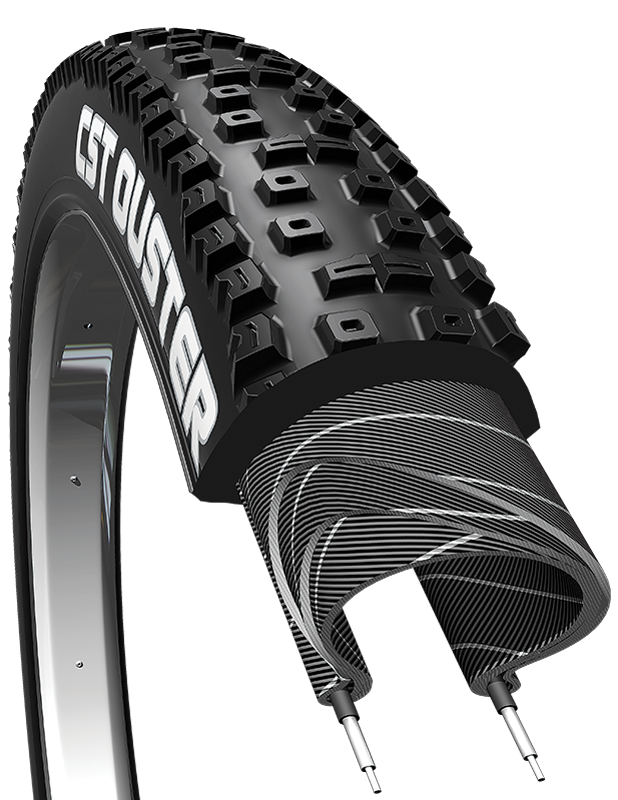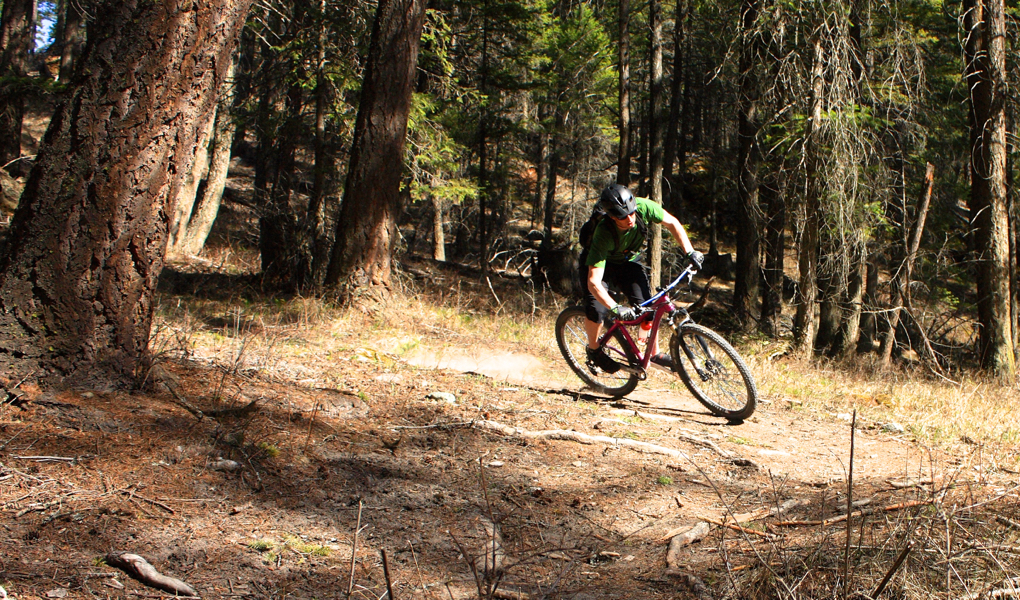
Tire: CST Ouster
Stated Size: 29” x 2.25”
Actual width on WTB i25 rim: 2.17”; 55mm
Casing: 60 tpi, folding bead
Blister’s Measured Weight: 746 grams
Intended Use: affordable knobbiness
Price: ~$35, USD
Mounted to: Canfield Yelli Screamy, WTB i25 rims
Duration of Test: ~15 rides
Locations: in and around Whitefish, Montana
Reviewer: 5’9” 150 lbs.
CST (Cheng Shin Tire) flies under the radar in most tire discussions. It seems they usually get discounted (pun intended) because their tires don’t cost an arm and a leg.
But the CST factory makes tires for some of the most well-known (and well-liked) brands on the market, so are they getting unfairly overlooked?
Last fall, a pair of CST Ousters showed up on my doorstep, and, with a brief 4-month hiatus called “winter in Montana,” I spent some time on them mounted to my beloved Canfield Yelli Screamy. Since most of my riding came late, and then early, in the season, I had a chance to test their mud clearing capabilities. But I didn’t get a chance to spend much time in sandier soils, so this review is pretty much limited to the hardpack, duff, and loam that we have a lot of around here.
Initial Impressions
The CST Ouster comes in two different sizes: 2.25” (tested) and 2.4.”
They’re also available in 26″, 27.5″, and 29″ wheel sizes, and in both wire and folding versions for each. (To reiterate, yes, CST still makes them for 26” wheels.)
In an age where it seems like tires and rims keep getting bigger and wider, the Ouster is relatively small. By the numbers, they’re only 1mm narrower than the WTB Trail Boss (the tires that I was using previously), but that number doesn’t quite tell the whole story.
The Ouster’s sidewall doesn’t balloon out much – it has a fairly straight profile from rim to tread, and the side knobs are the widest point of the tire. This can be compared to tires like the WTB Trail Boss or a Maxxis Ardent that have a more round profile, with (depending on the rim width) the sidewalls curving out much farther.
Notwithstanding some issues I had mounting these up tubeless (see below), the Ouster seemed to be fairly well put together. They didn’t have any inherent wobbles to them that you’ll sometimes find with cheap tires, and they sport a dual-compound rubber on the folding version that I rode (although CST doesn’t give any information as to what, exactly, those compounds are).
The Ouster also has what CST call “EPS” which stands for Exceptional Puncture Safety. This is a “layer of proprietary rubberized poly-fiber material between the tread and the casing” that’s intended to help prevent punctures. Montana doesn’t have a lot of goat heads or other such pointy enemies of inflated tires, so I’m not sure I would have gotten any flats anyways, but I can report that I didn’t get any flats.
Mounting
CST doesn’t advertise the Ouster as being tubeless compatible, but I figured with a bit of Stan’s they’d probably seal up alright.
Not so much.
Try as I might, I couldn’t even come close to getting the Ousters to seal up and hold air. The sidewalls were too porous for the Stan’s to handle, and there are some ridges on the bead (leftover from the molding process) that keep the bead from making an airtight seal.
So, after making a bit of a mess, I resigned myself to run them with tubes. Not a huge problem, but if you’ve sworn off tubes, these probably aren’t the tires for you.
The Design
The Ouster has medium height, blocky knobs that are fairly open:

The pattern is vaguely reminiscent of the now defunct Maxxis Mobster; paddles, paired with square-ish knobs to either side of the tire’s centerline. There’s a well-defined channel between the middle knobs and the side knobs, and the side knobs are fairly closely spaced.
The side knobs as well as the center paddles get some shallow siping, and the side knobs are partially buttressed on the outside. The center knobs have a very slight ramp to them, but all of the knobs are pretty blocky.
The Ride
The first thing that I noticed when I got on the Ouster was that, after spending a fair amount of time on higher volume tires that were set up tubeless, there’s a noticeable difference in ride quality going back to a lower volume tire with tubes. They just feel a bit harsh, which is extra noticeable since they’re on my hardtail.

I played around with tire pressure a little bit, but I settled on running them at about my “normal” pressure, which is around 28 psi for the front, and 30 psi for the rear. Lower pressures might have been a bit more forgiving, but I don’t like getting flats.
Part of that harshness was, no doubt, from the tubed set up. But I think part of it was also from the aforementioned tire profile – the sidewalls don’t have the ballooned shape that makes the ride a bit cushier.
That said, if you find that ballooned sidewalls make the tire too squishy and you’re looking for a stiffer tire in a relatively narrow package, then the Ouster fits the bill.
Climbing on the Ouster was fine. Not mind-blowingly fantastic, but no real complaints. Its decent paddle-shaped knobs are effective on loose climbs.
While the Ouster rolled along decently given its size and knob shape, it’s not a tire that I’d consider a contender if rolling speed is your primary consideration.
Braking on the Ouster was pretty good – the knobs aren’t nearly as large as a more DH-oriented tire, but in a straight line, the Ouster did a good job of slowing me down from speed. Braking while leaned over wasn’t bad by any means, but was a bit less consistent. They’d occasionally skip out to the side, albeit in a reasonably controlled manner.
Cornering on the Ousters was another spot where, all things considered, they weren’t bad. As you’d expect with a tire with a defined channel between the center knobs and side knobs, the Ouster is fairly drifty. And like most tires with blocky side knobs that are set apart from the center knobs, there’s a lean angle that you’ll hit when the side knobs dig in and you can coax a decent amount of grip out of them.
I never felt like the side knobs of the Ouster really locked in to the extent that you can get out of some of the well regarded knobby options (Maxxis DHF & company), but I could still get around a corner at a respectable clip on the Ouster.
Along those same lines, since they don’t lock into a turn as tenaciously as some other tires, I found that I needed to pay a bit more attention to them – they’ll release and send you drifting to the outside of a corner if you’re not careful. If you pay attention, you can feel that breaking point coming, but it meant that I never quite trusted them enough to fully commit to a sketchy corner at speed.
On occasion, when I was asking a bit more of the tires in a corner, they’d just kind of give up. The back end would step out, or the front end would knife in. This wasn’t horrible by any means, and it was generally pretty manageable, but it kept me from really getting excited about the Ouster’s cornering ability.
Mud
CST markets the Ouster as a good tire for mud, and as I mentioned above, I spent some time in some sticky, wet dirt. I didn’t get them out in any of those “I’m going to have to rebuild every part of my bike tonight” sort of rides, but I at least rode them in some conditions that’d gum up more tightly spaced tires.
All in all, the Ouster once again did pretty well; they didn’t pick up a lot of mud, and when they did, they shed it pretty quickly. The only thing I’d change would be the little holes cut into some of the center knobs – those pack up with mud pretty quickly.
Durability
I only have about 15 rides on the Ouster, which isn’t really enough time to fully assess their durability. In that time, the front tire is still in good shape, but the knobs on the rear tire are starting to round off a little bit. It seems like it might be wearing a little quicker than I’d expect, but it’s not horrible by any means.
The sidewalls show some scuffs from slapping them sideways into some manner of trail detritus, but so far, no cuts or tears.
Bottom Line
The big story with the CST Ouster is, without a doubt, it’s price — it’s less than half that of a lot of tires on the market these days, and there’s not much else out there that touches the Ouster on the price / performance ratio. While the Ouster is not the greatest tire I have ever ridden, it is far from the worst tire I’ve ridden—I’ve spent time on plenty of tires that cost twice as much and that I dislike ten times more.
If you’re looking to impress your endurbros with the best, most badass tire on the market and cost is not an issue, the Ouster probably isn’t what you’re looking for. But if you’re (a) ok with running tubes and (b) you’re looking for a very reasonably priced tire that does well in mud and also does alright in most other situations that favor a moderately knobby tire, the Ouster is a solid option.

Nice to read a good write up on some budget tires, Thanks for that. I had a different model CST and it was everything you described in the 2.25 format. Smallish and pretty good. For the price it met expectations, and I was happy.
CST owns Maxxis, but should not be confused with Maxxis quality as CST is serving a different market.
We’ve all probably run CST tubes at one time or another as CST brand, or another brand name. Good stuff.
I also dig that the tires are 75% of the performance of top end tires with less than 50% of the price tag. Necessary with how expensive MTB is becoming.
P
I run both folding CST Rock Hawks and Patrols in 2.25 size. I get them for $52 a pair to my door, and they are phenomenal. I live and ride in the SoCal high desert and they work great. I haven’t settled on which tires I like best as the Patrols roll great and weigh 687g while providing ‘decent’ traction, and the Rock Hawks grab like a goat, but weigh 965g and don’t roll nearly as well.
Great tires for the everyday rider who has other bills to take care of.
Fast forward to 2023. I have the CST OUSTER 29X2.4″ EPS 60 TPI and they do seal up fine tubeless on Ryde Trace 25mm rims. Cream II and Stans tape
I got 2 pairs for $35 each. That’s 4 tires and 4 tubes for $70. Currently Amazon has them at a higher price $38 a pair with tubes because I gave a review I think.